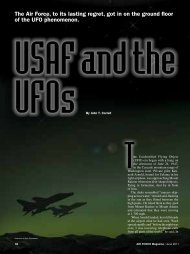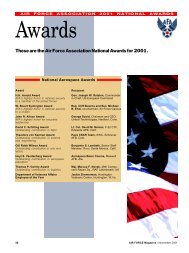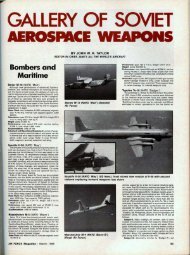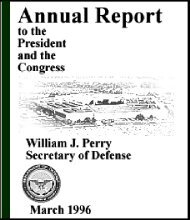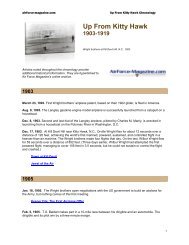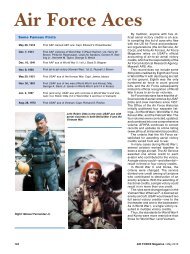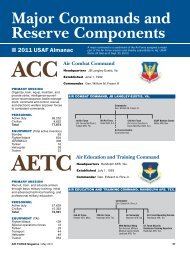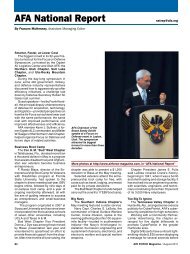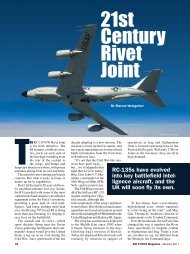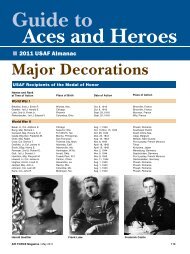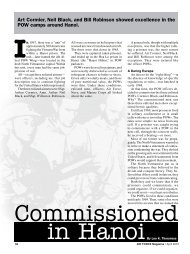0701crash - Air Force Magazine
0701crash - Air Force Magazine
0701crash - Air Force Magazine
You also want an ePaper? Increase the reach of your titles
YUMPU automatically turns print PDFs into web optimized ePapers that Google loves.
Lockheed photo via Jay Miller<br />
opment of aircraft that would fly<br />
higher and far faster than the U-2 in<br />
the expectation that its speed and<br />
altitude would make it invulnerable,<br />
if not invisible, to Soviet air defenses.<br />
Nor did the paper report that<br />
one of these top secret A-12 aircraft,<br />
which had been developed under a<br />
program designated Oxcart and<br />
looked unlike anything that had ever<br />
flown, had crashed just two days<br />
earlier.<br />
On May 24, 1963, Kenneth S.<br />
“Dutch” Collins was making a subsonic<br />
engine test flight, flying very<br />
slowly just above a solid layer of<br />
clouds. He was accompanied by Jack<br />
W. Weeks in an F-101 Voodoo chase<br />
airplane. When Collins saw that<br />
Weeks’s F-101 could not stay up<br />
with his A-12, he told Weeks to continue<br />
on to the base alone. Shortly<br />
afterward, when Collins flew into<br />
the clouds, his A-12 suddenly stalled,<br />
pitched up, and went completely out<br />
of control—the result of an erroneous<br />
airspeed reading. Collins was<br />
able to eject safely from the airplane,<br />
which went into an inverted<br />
flat spin and then crashed 14 miles<br />
south of Wendover, Utah.<br />
Because Collins was on a lowaltitude<br />
subsonic flight, he was wearing<br />
a standard-issue flight suit instead<br />
of a pressure suit. The more<br />
conventional flying attire prevented<br />
him from facing a difficult set of<br />
questions from the truck driver who<br />
stopped to pick him up and then at<br />
the highway patrol office. From there,<br />
60<br />
he contacted officials at Area 51 in<br />
Nevada, where the airplane was<br />
based, to let them know that their top<br />
secret airplane had gone down.<br />
A combination of means was used<br />
to prevent unwanted attention and<br />
discussion among the local population<br />
as well as accurate press reports<br />
on the incident. Individuals at<br />
the crash site were requested to sign<br />
agreements committing them to remain<br />
silent about what they had seen.<br />
Two farmers, who arrived near the<br />
crash scene in a pickup, were told<br />
that the airplane had been carrying<br />
atomic weapons—which was not<br />
true but effectively curtailed their<br />
interest in getting any closer to the<br />
CIA’s secret spyplane. Meanwhile,<br />
the press was told a different and<br />
less alarming but also false story—<br />
that the airplane that crashed was a<br />
very unclassified Republic F-105<br />
Thunderchief. Even official records<br />
listed the crashed airplane as being<br />
an F-105.<br />
Shattered Fighter<br />
In addition to producing aircraft<br />
like the U-2, Oxcart, and SR-71,<br />
Lockheed’s Skunk Works produced<br />
the F-117A stealth fighter. In 1982,<br />
eight years after the experimental<br />
Have Blue program began testing<br />
the concept of a faceted aircraft to<br />
reduce radar cross section, Lockheed<br />
delivered the first of the new, oddlooking<br />
fighter–bombers. By July<br />
1986, trade journals and writers had<br />
turned out a number of articles on<br />
In 1963, curiosity seekers heading for the crash site of a CIA top secret A-12<br />
like this one turned away on hearing that the airplane had been carrying<br />
atomic weapons. The press was told the aircraft was a commonplace F-105.<br />
what some called the “F-19” stealth<br />
fighter. The Testors company even<br />
produced a model of what the airplane<br />
was supposed to look like, but<br />
it bore no resemblance to the real<br />
thing. That fact undoubtedly pleased<br />
those working on the secret program.<br />
On July 11, 35-year-old Maj. Ross<br />
E. Mulhare, assigned to the 4450th<br />
Tactical Group, took off from Tonopah<br />
Test Range in Nevada and<br />
flew his aircraft into California airspace<br />
on what would prove to be his<br />
last flight. Mulhare, a 1974 graduate<br />
of the <strong>Air</strong> <strong>Force</strong> Academy, told his<br />
friends and members of his family in<br />
New Jersey that he flew F-5E fighter<br />
airplanes in mock combat missions<br />
against pilots from Tactical <strong>Air</strong> Command.<br />
From April 1978 to March<br />
1980, he had flown such missions<br />
from Nellis AFB, Nev., the official<br />
home of the 4450th. That was followed<br />
by F-15 assignments in the<br />
US and overseas. In August 1985 he<br />
joined the 4450th. The group was an<br />
F-117A squadron and Mulhare was<br />
one of the squadron’s pilots.<br />
Shortly before his flight, Mulhare<br />
was overheard telling a colleague<br />
that he was tired and “couldn’t shake<br />
it.” Despite his physical condition,<br />
Mulhare took off at 1:13 a.m. Pacific<br />
Daylight Time—such late night<br />
flights were intended to prevent discovery<br />
of the airplane’s unique<br />
shape—and proceeded westbound<br />
into the eastern portion of the San<br />
Joaquin Valley. He flew down the<br />
eastern side of the valley toward<br />
Bakersfield. At about 1:45 a.m.,<br />
Mulhare’s airplane went into a steep<br />
dive and smashed into a hillside<br />
about 17 miles northeast of that city,<br />
just inside the Sequoia National<br />
Forest. Mulhare was killed.<br />
The physical damage to the aircraft<br />
was such that one of the crash<br />
investigators described it as “without<br />
exception ... the worst crash I<br />
have worked.” He went on to observe<br />
that while there was only light<br />
fire damage to the airframe, “the<br />
structural breakup was almost absolute”<br />
and that “ ‘shattered’ may best<br />
describe the aircraft after impact.”<br />
As a result, identification of special<br />
components was frequently impossible.<br />
The crash also started a moderately<br />
intense ground fire, which spread<br />
through the surrounding hills, eventually<br />
burning 150 acres of range.<br />
While the aircraft fire had gone out<br />
AIR FORCE <strong>Magazine</strong> / July 2001


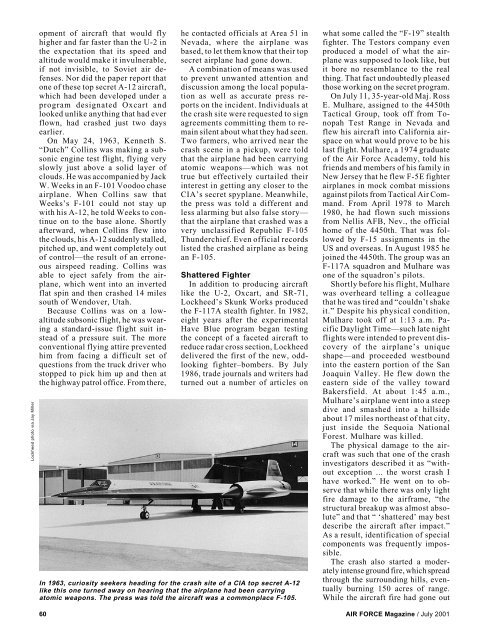
![[PDF] Foulois - Air Force Magazine](https://img.yumpu.com/13391007/1/190x253/pdf-foulois-air-force-magazine.jpg?quality=85)
